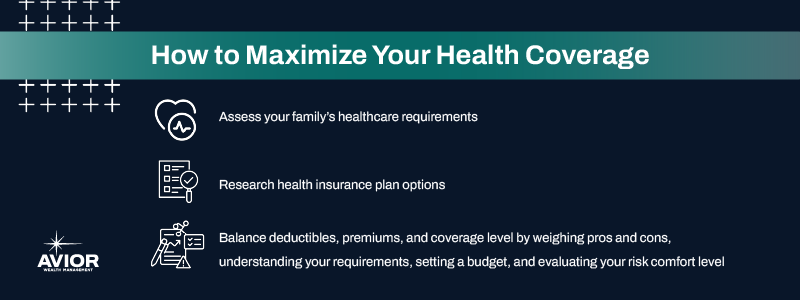How to Maximize Your Health Coverage
It’s challenging to balance each cost and risk associated with health care. Learn how to leverage coverage optimization for the right level of protection.

Health care costs are one of the biggest expenses for Americans. The average annual spend for an individual is about $13,500, and health care spending makes up around 17% of the gross domestic product.
Needless to say, you should do everything you can to maximize your protections while reducing health insurance costs. The right approach to coverage optimization will help you meet your health care needs and consider financial constraints.
Health care coverage optimization is all about ensuring you are making your monthly premiums and benefits work the most for what you’re paying. This guide walks through key ways to maximize protection with the right optimization tactics.
Assess your health care requirements
First, evaluate your needs and your family’s health care needs. Having a deeper understanding of necessities will allow you to make better decisions about your plan. Consider factors like:
- Any chronic conditions you or your family is dealing with
- Regular medications you rely on and their costs
- Family medical history
- Personal health history
- Typical frequency of provider visits
- Lifestyle choices and habits
- Potential health risks and future scenarios
Reflect on any risk factors for your family and take a look at medical records. For example, if you smoke, you may have a higher risk of developing a serious condition.
Talk to your health care provider about what the future could look like. All of these factors will impact your specific insurance requirements.
Understand health insurance plan options
There are several types of insurance plans that may be right for you, depending on your employment situation and your budget. Let’s look at common options and their pros and cons.
- Health maintenance organization (HMO): This plan can be very affordable, but you’re limited in the health care providers you can see. They must be in the HMO network to be covered, and the primary care physician must refer you to other specialists.
- Preferred provider organization (PPO): As the name implies, PPOs allow you to see health care providers of your choice, even if they’re not in-network. You may pay less when you use network providers, however. Note that this flexibility leads to more costly monthly premiums.
- Exclusive provider organization (EPO): EPOs are more limited, where policyholders must use the network providers to receive coverage for services. These can also be more affordable.
- High-deductible health plan (HDHP): Many people choose an HDHP to save money on their monthly premiums. However, you may end up paying a lot more since your deductible is higher, meaning you have a larger responsibility to pay before the insurance kicks in. A pro is that these plans are eligible to be used in combination with a health savings account (HSA).
Young and healthy policyholders may be more concerned about monthly premiums since they may not have many other health care costs throughout the year. However, people with chronic conditions or severe illnesses may prioritize using the doctor of their choice and receiving more coverage for a higher premium. Weigh each factor against your family’s health care factors and goals.
Balance coverage, deductibles, and premiums
Coverage optimization requires the right balance of the biggest insurance cost factors: coverage level, deductible, and premiums. Here are a few strategies to help you balance these components more effectively:
1. Understand the benefits and downsides of all options
Many people simply settle for whatever health insurance plan is in front of them. However, do plenty of research to make sure you’re getting the best arrangement. Contact different providers, thoroughly research the options your employer provides, if applicable, and look for a plan that aligns with your unique requirements and priorities.
2. Consider the coverages you really need
Everyone’s situation is different, so there is no one right answer to how much coverage you need. But think through what the nonnegotiable requirements are for you and your family and which options are just extra protections you would like to have.
3. Set a monthly budget
Be clear on the monthly premium amount you can afford. Look at all your other expenses and make sure health insurance is at the top of the list. You may need to cut down on other monthly expenses to afford the coverage you and your family really need.
4. Invest in a health savings account
HSAs are common for people with HDHPs because of their tax benefits. As long as you use the HSA savings for qualified medical expenses, your contributions and withdrawals are tax-free. Qualified expenses include costs like doctor visits, prescriptions, and mental health care.
5. Understand the trade-offs and risks
When you’re trying to balance your monthly premiums with your deductibles, consider the amount of risk you’re willing to take on. Having a high deductible may lower your monthly premiums, but if you suddenly need a lot of treatment, you may be on the hook for more money. Some people unfortunately may even avoid seeking medical help because of high costs.
So, if you have a chronic condition, a high-deductible plan may not be the best option, but it could also be a good choice if you don’t expect to use your insurance plan that much and just pay for the lower premium each month.
6. Factor in other types of coverage
Don’t forget to balance your health insurance coverage with other types of insurance you may need, including dental, vision, and supplemental plans. Aside from HSAs already discussed, another option is a flexible spending account, which helps you manage your out-of-pocket health care expenses throughout the year.
Maximize your health care investments with Avior
Being thoughtful and intentional about your health care coverage is key to optimizing costs and maximizing protections. Outline your family’s specific needs, consider what needs could arise in the future, and consider your monthly budget and willingness to take risks. Regularly reviewing your plans and making updates when you go through major life changes are also key to ongoing optimization.
Talk to the team at Avior when you’re weighing costs and coverage with your health insurance options. Our team can help you align your coverage choices with your ongoing financial goals.
Contact Avior to get started today.
Disclaimer: Nothing contained herein should be construed as legal or tax advice. Avior and our Advisors will work with your attorney and/or tax professional to assist with your legal and tax strategies. Please consult your attorney or tax professional with specific legal and/or tax questions. Investment Management and Financial Planner are offered through Avior Wealth Management, LLC, an SEC-registered investment advisor. Past performance is not a guarantee of future results. Investments are subject to loss, including the loss of principal.
No Comments
Sorry, the comment form is closed at this time.




